When The Women's Bank opened its doors in the Equitable Building on July 14, 1978, Denver banking history was forever changed — and a concept Carol Green and Bonnie Andrikopolous developed in November 1975 came to life.
Green had founded the Franchise Services of America after achieving success with Weight Watchers franchises in the Denver area. Andrikopolous had worked as a lobbyist for the National Organization for Women (NOW) and served on several boards in the state, including the Colorado Commission on Women and the Colorado Supreme Court Nominating Committee.
Green and Andrikopolous formed The Women's Association on November 16, 1975, with the purpose of securing a national bank charter. In a circa-1976 brochure, the association explained the need for a bank catering to women:
It is a well known fact that women are essentially at the 'roots of finance'....from the everyday financial considerations of a household budget to financial matters concerning all forms and sizes of businesses. ...Although our first consideration will revolve around the active roles of women in Denver, we are creating a bank that will serve all.
As Women's Bank incorporator Judith "Judi" B. Wagner and former Bank President B. LaRae Orullian explained, women also faced challenges when it came to credit:
Although the Equal Credit Opportunity Act passed in 1974, most women did not know the law existed. Bankers frequently told women that they needed their fathers, husbands, brothers, grandfathers, uncles or some related male to co-sign for their loans. Getting their own credit was difficult.
(Foreword to The Women's Bank: A Denver Success Story by Thomas J. Noel & Gail M. Beaton)
Prior to 1974, women certainly utilized banking services. In fact, after the 19th Amendment was ratified in 1920, banks began advertising more directly to women. Despite courting more customers, financial institutions remained largely discriminatory when it came to issuing credit to women and minorities. The industry of financial services itself was led by men (who were, more often than not, white), while women worked as receptionists, secretaries, and tellers.
By July 1977, through the hard work of many, The Women's Bank received preliminary approval for a national charter from the Comptroller of the Currency. Those who authored the application included Wendy W. Davis, Loretta Norgren, Leslie Friedman Davis, Betty Sue Freedman, Beverly A. (Martinez) Grall, Barbara Grall, Barbara Welch Sudler, Edna Mosley, Michael Feinstein, Carol Green, and Judith Foster.
Nationally-noted banker Mary Gindhart Herbert Roebling was also instrumental in securing the charter. Utilizing her contacts at the Federal Deposit Insurance Corporation (FDIC), Roebling had the health of bank's proposed systems checked.
On July 12, 1978, The Women's Bank officially became the second nationally chartered women's bank in the country (Washington, DC held the first). Two days later, The Women's Bank opened for business at 8:30 a.m. when President B. LaRae Orullian cut the ribbon on the front door entrance.
The first day's deposits exceeded $1 million.
By 1980, The Women's Bank's success and desire for expansion necessitated creating a holding company called Equitable Bankshares of Colorado, which was led by Judi Wagner.
By 1982, The Women's Bank's boasted $20 million in deposits and low loan portfolio delinquency (under 1%, while the nationwide rate was 2.5%). By then, the bank's increased to the number of men it served to 40% of its customer base.
Orullian cited The Women's Bank's approach to outreach as the key to success. The bank offered an extensive array of financial education seminars and partnered with community organizations including Big Sisters of Colorado, Inc. and Safe House.
In January 1994, The Women's Bank and its holding company, Equitable Bankshares of Colorado, were sold to an investor for $17.5 million. Both were renamed the Colorado Business Bank in October 1995. In October 2018, Tulsa-based BOK Financial purchased the Colorado Business Bank.
Sources Cited
- The Women's Bank : a Denver success story
- The Women's Bank records, 1976-1997
- LaRae Orullian papers, 1977-1987
- Betty Freedman papers, 1976-1977
- Denver Business Journal, October 2, 2018
- Denver Downtowner, February 24, 1982
- Denver Post, July 6, 1977; January 30, 1994
- Rocky Mountain News, July 15, 1978

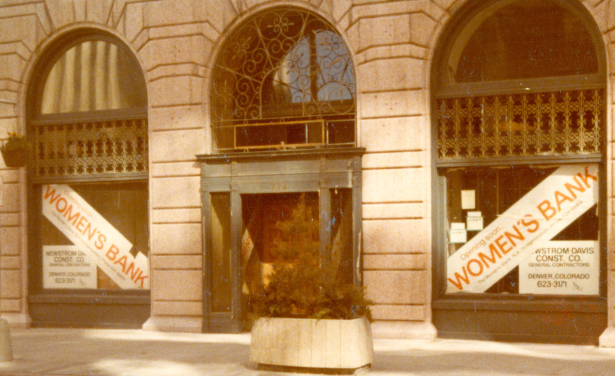
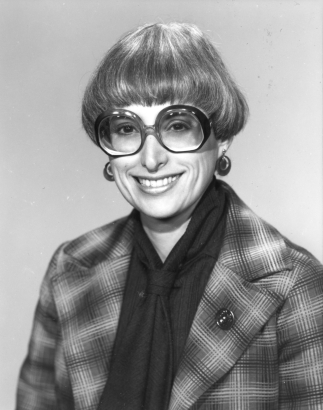

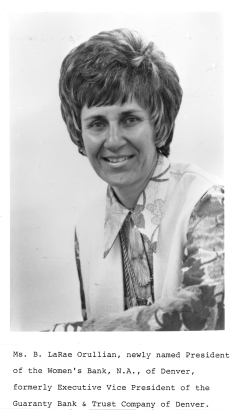
![Advertisement for the International Trust Company, Denver Post, October 24, 1922. [Note: ad contains harmful and racist language]](/sites/history/files/styles/blog_image/public/October_24_1922.jpg?itok=J58BQ4S8)
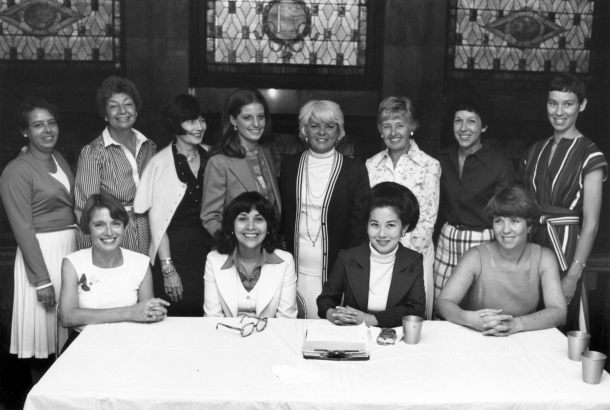

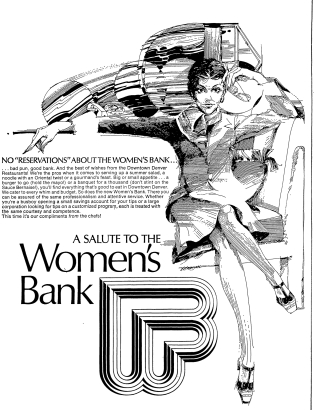

Comments
It is the National
It is the National Organization for Women.
Thanks for bringing my
Thanks for bringing my attention to the error, Judy. Now corrected.
Not sure info correct. I had…
Not sure info correct. I had a checking account and credit card in the '60.
It doesn't say no women had…
It doesn't say no women had accounts and/or credit cards. It does, however, explain that most women were not able to open those accounts in their own names. The info is correct and readily available to verify in multiple ways under the Equal Credit Opportunity Act of 1974.
If you had bank accounts and credit cards in your name without a husband, father, etc, you were part of a very lucky minority.
I was unable to get a…
I was unable to get a library card in my own name in Seattle , WA in 1970 - because I was married. Somehow at 5, I was entrusted with one in my own name in New York City.
I had two bank accounts…
I had two bank accounts before '73 with no male signature!
I had two bank accounts…
I had two bank accounts before '73 with no male signature!
Marguerite, I’m glad to read…
Marguerite, I’m glad to read you were treated the same as men, and were granted a credit card in 1960. However, if the bank had refused, you had zero recourse because the law allowing women to obtain a credit card without a male co-signer came into effect in 1974. Another possibility - did you have a bank card? Not a credit card? A bank card must be paid in full when you receive the bill. Bank cards do not allow us to carry a balance.
I don't know if i should be
I don't know if i should be puting my name into the website.
Celebrating the legacy of the
Celebrating the legacy of the Women's Bank: 'A Bank For All People' – a reminder of their pioneering efforts in financial inclusion <a href="https://keepnetworth.com/">read more</a>. By remembering their efforts, we can strive to create a more equitable economic system for all. Read more to explore the history of the Women's Bank.
Add new comment